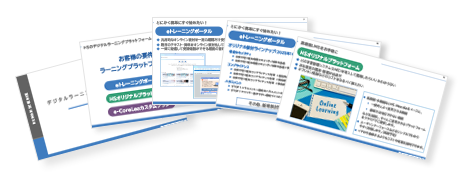2017.11.01
e-Learning in Corporate Training Basics ③ (e-Learning and Group Training)
In the first part of this series, "E-Learning in Corporate Training: Basics ① (Introduction)", we touched on the topic of e-learning, which broadly refers to various forms of learning using IT. It is common to manage learning using a Learning Management System (LMS).
This time, we will introduce the advantages and disadvantages of e-learning by comparing it with classroom training.

1. Various Names for e-Learning
This may seem a bit off-topic, but different companies and organizations refer to e-learning in various ways. How does your organization express it? There may be other terms besides the ones listed below.
| ・e-Learning (e-Learning/e-learning) ・Web Training, Web Education ・Web Training ・Web Learning ・Videos, Video Materials (also includes moving elements other than video) |
・WBT (Web Based Training) ・CBT (Computer Based Training) ・Online Learning ・e-Learning (reading only) ・eL (writing only) Others |
It seems that companies have been using WBT and CBT since the early 2000s during the dawn of their introduction.
2. e-Learning vs. Group Training
There are the following differences between e-learning and group training. Depending on the situation and educational content, it is necessary to choose educational methods that leverage strengths and consider weaknesses.
For example, e-learning becomes more valuable when there are participants nationwide or when working hours vary, but it is also evident that there are issues such as a tendency for participants' motivation to decrease (leading to lower learning effectiveness). On the other hand, group training can vary significantly in effectiveness depending on the instructor's skills and compatibility, and it tends to become more costly as the number and quantity increase.
| Features of e-Learning | Features of Group Training | |
|---|---|---|
| Time | ◎ No travel time required ◎ Available for learning anytime ◎ Progress at your own pace ◎ Fast-paced information delivery is also possible |
△ Movement of participants and instructors is necessary △ Participation is only possible at designated times |
| Location | ◎ Anywhere you can connect to the network | △ Venue Required |
| Cost | ◎ Relatively inexpensive (system and content costs) | △ Relatively high costs (venue fees, travel expenses, etc.) |
| Example | △ On the one hand, while we can provide the same quality and content, there is often a lot of flat content to appeal to many people. △ On the other hand, communication is difficult as it is one-sided. |
◎ It is also possible to adjust the content based on the participants' reactions ◎ You can ask questions until you fully understand |
| Instructor | ○ No need for unnecessary or video appearances. High teaching ability (facilitation, etc.) is not required if knowledge is present. | △ High-quality training requires not only experience and knowledge but also high teaching ability. |
| Participants | △ A strong awareness of oneself (or someone whose face is not visible) tends to lower motivation | ◎ High motivation/effectiveness depending on the understanding of the supervisor and the instructor |
| Operations Manager | ◎ Able to manage learning outcomes data △ IT knowledge required |
△ Schedule adjustments, handling of absentees, etc. are necessary |
| Appropriateness | △ Suitable for knowledge acquisition, not suitable for practical skill acquisition | △ Suitable for practical and advanced learning, not suitable for knowledge acquisition |
* Evaluations may vary depending on various implementation conditions and services used.
3. Reasons to Implement e-Learning
Although there are often complex reasons (including those not listed below) for the choice, the reasons companies decide to implement e-learning are often cited as follows.
- Cost reduction (instructor, venue fees, travel expenses)
- Distance Education (Dispatching instructors nationwide and overseas is unrealistic)
- Standardization of Education (Same content, anytime, anywhere)
- Learning management available
- Burden reduction (it is difficult for the participants to gather at the same time and place) etc.
4. Services that complement each other's shortcomings

The use of various systems and technologies that complement the advantages and disadvantages of e-learning and group training is also progressing.
- ・Cloud LMS:
- Reduce operational burden and costs, even when IT knowledge and support are not required
- ・Blending Training / Flipped Learning:
- Combine the advantages of e-learning and group training
- ・Video・VR・Microlearning, etc.:
- Knowledge retention, skill acquisition, and behavioral change are possible
- ・Social Learning:
- Communication between participants and instructors (SNS, etc.)
- ・Adaptive Personalized Learning:
- Provision of content tailored to individual characteristics and circumstances
- ・Microlearning:
- A system for human resource development that not only emphasizes brevity but also leverages the characteristic of being concise
When introducing e-learning for the first time, it is necessary to consider the implementation of an easy-to-use cloud LMS and the blending of existing group training, but introducing other systems or technologies is often premature.
It is advisable to carefully consider costs and necessity before proceeding.
5. Failing e-Learning
However, due to reasons such as not being able to fully utilize strengths and not being able to cover weaknesses, it is difficult to say that many e-learning programs are being fully utilized.
We plan to introduce the characteristics of failing e-learning and successful e-learning in future blog topics.
Past Articles: "e-Learning Basics in Corporate Training" Series
① Introduction: e-Learning and its differences from traditional education, etc.
② Theory Section: Instructional Design (ID), etc.

Author:
Keigo Tachino
Education Solutions Department Consulting Unit
・Experience as a training instructor, web designer, etc.
・Engaged in instructional design, e-learning development, etc.
・Learning Designer (eLC certified)
・ATD International Professional Member
Case Studies of Companies that Have Implemented Our Services e-Learning Services
Case Study Collection
From support for the introduction of e-learning to the production of teaching materials, Human Science offers a variety of services related to e-learning.
In this case study collection, you can view the implementation examples of five companies that have used our services. Please take this opportunity to download it.

[Introducing Companies]
- Fuji Xerox Service Creative Co., Ltd.
- NIPPON DENSETSU KOGYO CO.,LTD. Dear
- Sanken Electric Co., Ltd.
- The Open University of Japan
- Okinawa Institute of Science & Technology Graduate University Dear
5 case studies of companies












